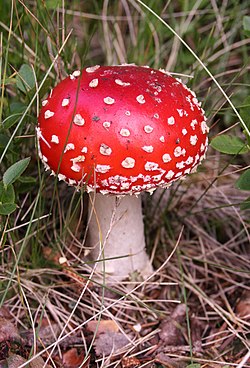Is SOA better kept in the dark, or in the spotlight?

Should SOA be regarded as a fungus, growing out of sight in a dank, subterranean environment, or should 
I was pleased to join one of Dana Gardner's SOA recent podcasts ("the Gardner Gang"?), in which a number of fitting analogies for SOA were bandied about.
Perhaps the most amusing, but entirely appropriate, analogy was put out there by Jim Kobielus, who liken SOA to the world's largest living organism, a 50-square mile mushroom in Michigan.
As part of a discussion of SOA being similar to a "root system" for enterprise IT, Jim took the analogy a step further, observing that SOA is more like "a very complex hyper-mesh:"
"In other words, like a root system, where you have tendrils going hither and yon, the tendrils being simply interactions among services and client... SOA becomes this ubiquitous root system from which new sprigs can pop up, without needing to lay down their own root system. Rather they are simply branches on a huge underground system. In Northern Michigan, where I’m from, scientists have discovered the world’s largest organism, as a mushroom or a fungus of some sort that spans 30, 40, or 50 square miles. They determined though DNA analysis that it's the exact same individual and has got the largest biomass in the world. In essence -- and it’s all underground pretty much. That’s what SOA is all about, essentially all the services in an SOA sort of share a common DNA."
Not a pretty picture, and probably not the best way to sell SOA to the organization. (Kind of like packaging sushi as "cold, wet, dead fish.") But it does make a lot of sense. You could  go to Michigan and lop off large chunks of the mushroom, but the other parts will continue to thrive, as it exists as a collection of parts that aren't dependent on one another. Isn't that what SOA is all about?
go to Michigan and lop off large chunks of the mushroom, but the other parts will continue to thrive, as it exists as a collection of parts that aren't dependent on one another. Isn't that what SOA is all about?
Now for a somewhat brighter analogy for the SOA business model -- the movie industry. Many smaller movie producers rely on a network of partners to deliver product. As Dana pointed out, a big monolithic enterprise with a command-and-control structure -- such as MGM -- can have its own infrastructure, and all of its own developers. "On the other hand, if you want to be a small company, a green-field software-as-a-service organization, you want to only be in an ecology play where you’re acquiring things, and you’re going to plug them in and then rip them out, reuse as much as you can," Dana pointed out. "Then, you can be like a Miramax instead of an MGM. You’re going to do just independent films. You’re going to go in and spend a little bit of money, and maybe you’ll still come up with some great product that will be right fit for your market."
Just as technology has lowered the barriers to entry for film production, the barriers to enterprise IT are also being lowered by SOA, Tony Baer added:
"The technology for producing films and videos has become much more accessible, and therefore you have now an independent film industry. So, that's analogous to the infrastructure that has become much cheaper, much more open, which is what SOA can do. In turn, you look at the business model. It's become more interchangeable, so that a studio might collaborate. Let’s say that Universal might work with Sony -- collaborate on a picture -- because it’s so costly that neither one of them could do it themselves. Well, they have the infrastructure and the business process in place that enables that to happen. Meanwhile, an independent film like "Crash" comes out of nowhere last year and wins the Academy Award for best picture of the year, and it’s all possible because you now have this more accessible infrastructure. The moral of the story for SOA here, trying to bring this back on topic -- is that if you get the plumbing down right -- you don’t have to be an SAP to introduce a killer app anymore."